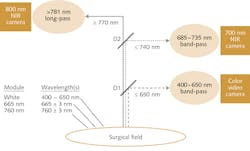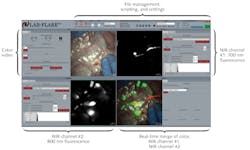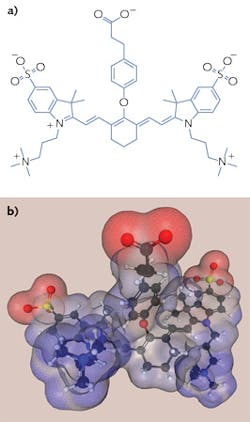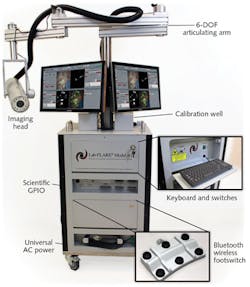Fluorescence-guided Surgery: Advanced surgery: NIR fluorescence guidance arrives

DAVID J. BURRINGTON
As much as surgeons might wish for "x-ray vision," the reality is that the human brain and eyes are restricted to perceiving a very narrow sliver of the electromagnetic spectrum called visible light, which spans roughly 400–700 nm. Because of this, many objects able to provide helpful information during surgery are invisible to the unaided eye. Even a thin layer of blood or tissue, just hundreds of microns in depth, can completely obscure a surgeon's vision.
Some objects, such as malignant tumors, need to be resected fully for cure, but finding small collections of cells in the context of normal tissue remains a significant challenge. For example, even today, between 30 and 40% of all breast cancers are left behind during the initial surgery,1 resulting in the need for either repeat surgery and/or adjuvant therapy. Conversely, objects such as blood vessels, nerves, and bodily lumens need to be avoided, as damage to them during surgery results in high morbidity.2,3
Expanding the surgeon's view
There is a constant tension in modern oncologic surgery between the diametrically opposed goals of maximizing both tissue resection and tissue avoidance:
- Take out too much tissue and the cancer might be cured, but complications from the surgery create a lifetime of suffering caused by a combination of physical and/or emotional pain and follow-up care costs; or
- Remove too little tissue and the cancer may spread and kill the patient.
Solving this conundrum is the reason John V. Frangioni, M.D., Ph.D., developed FLuorescence-Assisted Resection and Exploration (FLARE) technology4 while he was a full-time Professor of Medicine and Professor of Radiology at Harvard Medical School (Boston, MA). FLARE is an optical imaging platform that combines state-of-the-art engineering and chemistry to solve important biomedical problems. Rather than being constrained to visible light, FLARE expands the spectrum of the surgeon's vision up to 900 nm. In fact, this critical region from 700 to 900 nm, termed the near infrared (NIR) "window," is where the absorbance curves for biomolecules that constitute living tissue all reach local minima.
But absorbance is not the only reason the NIR window is so important. Wavelength-dependent scatter and autofluorescence are also much lower in the NIR compared to the visible. The final key property of NIR light is invisibility itself. Because the surgeon can perceive NIR light only as a faint red glow without assignment of wavelength or intensity, light used for both excitation and fluorescent emission can be made invisible. Being invisible means no change to the look of the surgical field—so surgeons can operate as they normally do.
Because of the invisibility of NIR light, two innovations are needed to make the technology work: an imaging system that generates and "sees" otherwise invisible NIR fluorescent light, and targeted contrast agents having the desired NIR emission wavelength. FLARE accomplishes the former using the optical system shown diagrammatically in Fig. 1 (which is the subject of issued patents in the U.S. and Europe). NIR-depleted white light and two independent channels of NIR excitation light illuminate the field-of-view (FOV), while three independent sensors image the FOV simultaneously and in real time.
Every FLARE imaging system is able to display four independent video streams, including a color video image of the surgical field (i.e., what the surgeon is accustomed to seeing), two independent channels of NIR fluorescence emission (one centered at 700 nm and one at 800 nm), and a merge of all three (see Fig. 2). The merged image permits a range of options, from simple overlay of images to real-time ratiometric imaging-which unlocks the potential of next-generation contrast agents that respond to environmental stimuli.In fact, FLARE's dual-NIR channel capability solves that longstanding problem of opposing goals: One NIR channel can be dedicated to tissue resection and highlighted using one color in the merged image, while the other independent channel can be dedicated to tissue avoidance and highlighted with a different color—all in real time.
Wavelength with targeting
Developing NIR fluorescence contrast agents that have the desired emission wavelength and desired targeting is a daunting task. FLARE accomplishes this in two ways. The first is the traditional approach of covalently conjugating a targeting ligand to a NIR fluorophore. Unlike conventional NIR fluorophores, however, FLARE uses a novel and proprietary class of "zwitterionic" NIR fluorophores that have geometrically balanced, electrically neutral polyionicity.5-7 These physicochemical properties result in extremely low non-specific binding and uptake in vitro and in vivo, and thus extremely low non-specific background. Zwitterionic NIR fluorophores are available at 700 nm (e.g., ZW700-1 Forte and its derivatives) and 800 nm (ZW800-1 and its derivatives; see Fig. 3), as well as in a variety of conjugation and linker chemistries. The Forte line of zwitterionic NIR fluorophores also provides extraordinarily high (>90% at 24 h) stability in warm serum.
The second approach to targeted NIR fluorophores is called "structure-inherent targeting."8 For this class of FLARE molecules, the targeted moieties are grafted onto the resonant backbone of a NIR fluorophore such that targeting and fluorescence is accomplished as a single molecular entity. To date, peer-reviewed literature from Dr. Frangioni's company, Curadel, has addressed structure-inherent targeting to cartilage, bone, parathyroid glands, thyroid glands, and adrenal glands, to name a few applications.
Availability
Curadel is currently refining and commercializing FLARE technology. Because of the future clinical potential of the technology, and to avoid any possible confusion by consumers, the company conducts its development and commercialization activities through two separate companies, with separate product offerings and labeling.The ultimate goal of FLARE is to empower surgeons to perform better surgery. All FDA- and EMA-regulated products for human use are being developed by Curadel's second subsidiary, Curadel Surgical Innovations (CSI). CSI plans to offer imaging systems and contrast agents under the Med-FLARE brand. At present, however, none of CSI's products have been approved by regulatory bodies, but efforts are currently underway to obtain marketing authorization.
For Dr. Frangioni, this has been a 15-year road that has been neither straight nor flat: "When we first started, we were told that it was a waste of time to develop the FLARE imaging system because there weren't enough contrast agents to use on it. So, once we developed the imaging system, we turned our attention to contrast agents and invented both zwitterionic NIR fluorophores and structure-inherent targeting. Now we're told that there is no market for optical imaging, and bringing contrast agents to regulatory approval will be too difficult and expensive. Well, OK, but after proof of principle of the technology in clinical trials involving over 500 patients worldwide, and with all studies published in peer-reviewed journals, naysayers are running out of excuses."
The promise of NIR fluorescence guidance are procedures that are faster, better, and cheaper. Only time will tell if these goals are met, but at least for the time being, NIR fluorescence is finally seeing the light of day.
ACKNOWLEDGEMENTS
FLARE, Lab-FLARE, Vet-FLARE, Curadel, Curadel Surgical Innovations, and Curadel ResVet Imaging are registered trademarks of Curadel, LLC.
REFERENCES
1. R. G. Pleijhuis et al., Ann. Surg. Oncol., 16, 10, 2717–2730 (Oct. 2009).
2. M. D. Michaelson et al., CA Cancer J. Clin., 58, 4, 196–213 (Aug. 2008).
3. W. A. Macrae, Br. J. Anaesth., 101, 1, 77–86 (Jul. 2008).
4. S. Gioux, H. S. Choi, and J. V. Frangioni, Mol. Imaging, 9, 5, 237–255 (Oct. 2010).
5. H. Hyun et al., Mol. Imaging Biol., doi:10.1007/s11307-015-0870-4 (Jun. 18, 2015).
6. H. S. Choi et al., Nat. Biotechnol., 31, 148–153 (Feb. 2013).
7. H. S. Choi et al., Angew. Chem. Int. Ed., 50, 28, 6258–6263 (Jul. 4, 2011).
8. H. Hyun et al., Nat. Med., 21, 2, 192–197 (Feb. 2015).
David J. Burrington, M.Ed., is quality system manager with the Translational Cancer Imaging Facility at Beth Israel Deaconness Medical Center (Boston, MA); e-mail: [email protected]; www.centerformolecularimaging.org/tcif.


